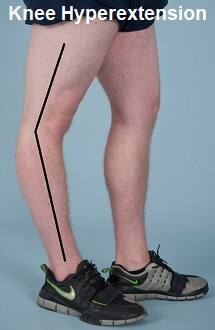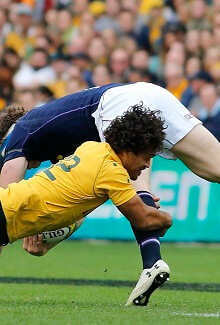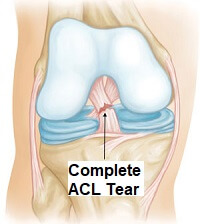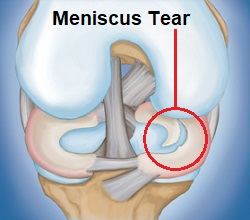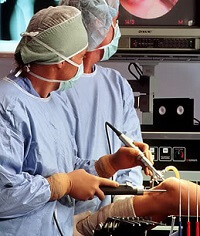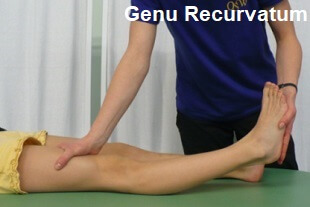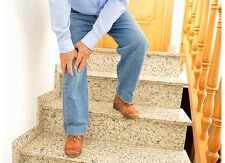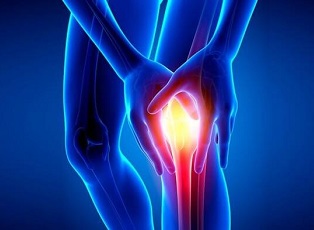- Home
- Knee Pain Diagnosis
- Hyperextended Knee
Hyperextended Knee Injury
Written By: Chloe Wilson, BSc(Hons) Physiotherapy
Reviewed by: KPE Medical Review Board
A hyperextended knee is where the knee joint bends too far backwards.
Knee hyperextension can cause pain, swelling and instability and often affects daily activities and sports.
When the knee hyperextends, stress is placed on the knee structures, particularly at the back of the knee.
In severe cases, one or more of the knee ligaments may be over-stretched and either partially or completely tear. This can lead to long-term knee instability if left untreated.
Here we will look at the common causes, symptoms and associated injuries with a hyperextended knee and then we will go on to look at the best treatment options to ensure a full recovery and reduce the risk of ongoing instability and further injuries.
Types of Hyperextension
Knee hyperextension can be divided into two categories:
- Knee Hyperextension Injuries: the result of an injury where something forces the knee to momentarily hyperextend. This is usually a short term problem that settles down within a few weeks to months with no ongoing knee hyperextension
- Genu Recurvatum Syndrome: where the knee naturally rests back into hyperextension whenever the leg is straight. This is an ongoing condition where the hyperextended knee is persistent, and is usually associated with ligament laxity or various medical conditions rather than an injury
We will start by looking at knee hyperextension injuries as they are the more common problem and then we will go on to look at ongoing Genu Recurvatum Syndrome.
Hyperextended Knee Causes
A hyperextended knee is most commonly caused by a sporting injury but can affect anyone, being caused by anything which forces the knee joint to bend too far backwards.
The most common causes of a hyperextended knee are:
- Awkward Landing: Landing hard from a jump or being unbalanced as you land, particularly if landing on a straight leg, can lead to a hyperextended knee
- Sporting Tackle: a tackle at the front of the knee that pushes the joint straight backwards can lead to knee hyperextension
- Skiing: If the front of the skis hit something e.g. a snow bank, the skier’s body often keeps moving forwards while the feet are fixed causing hyperextension of the knee. This is especially likely if the bindings fail to release
- Running: If you suddenly stop when running, particularly if taking all your weight through one leg, or if your foot gets stuck in the ground, e.g. there is a hole or you are wearing cleats you may experience a knee hyperextension injury. Momentum keeps your body moving forwards while the knee bends backwards, particularly if the foot is fixed
- Piggyback Ride: If someone jumps on your back for a piggyback ride without warning it can pull you off balance and result in a hyperextended knee
What Prevents Hyperextension of the Knee?
The four knee ligaments, the anterior and posterior cruciate ligaments and the medial and lateral collateral ligaments are the main stabilisers of the knee joint. They are strong ligaments that hold the knee bones together, but if enough force goes through the knee, the ligaments over-stretch and the knee hyperextends.
Women are at greater risk of experiencing a hyperextended knee injury as their ligaments tend to be more lax than men’s which results in an increase likelihood of joint instability.
Hyperextended Knee Symptoms
Symptoms of knee hyperextension injuries will vary depending on how forcefully and how far the knee was pushed backwards and how much damage was done to the knee structures.
Typical hyperextended knee symptoms include:
1. Knee Pain
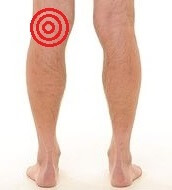
Localised knee pain is a common hyperextended knee injury symptom. People usually describe the pain as either a mild ache or sharp pain behind the knee, or occasionally a pinching type anterior knee pain if the structures at the front of the knee have been damaged.
It may range from mild/moderate pain in fairly minor injuries where there is minimal damage to the knee structures to moderate/severe pain if the soft tissues e.g. ligaments have been torn.
2. Knee Swelling & Bruising
Swelling behind the knee and bruising are common symptoms with knee hyperextension injuries. If one of the ligaments has been completely torn, swelling and bruising will be fairly immediate (within one to two hours) and is often profuse.
If the damage is more minor, such as a grade 1 or 2 ligament sprain or cartilage irritation, the swelling and bruising will slowly develop over 24-48 hours and is usually fairly mild.
3. Knee Instability
Instability is a common hyperextended knee symptoms and the knee joint may feel unstable when standing or walking after a knee hyperextension injury. It may feel like it is going to buckle underneath you or it may actually completely give way.
If the knee gives way it usually indicates that one or more of the knee ligaments has been torn, most commonly the Anterior Cruciate Ligament (ACL).
4. Restricted Knee Movement
Knee movement may be restricted after a knee hyperextension injury due to the build-up of fluid in the joint. The more swelling there is, the more knee stiffness is likely to be a problem.
5. Popping Sound
Knee hyperextension that is accompanied by a popping sound or sensation usually indicates that one of the knee ligaments has ruptured (completely torn). In most cases of hyperextension with knee popping it is the ACL that is torn which will result in immediate swelling and major knee instability.
You may experience, one, some or all of these hyperextended knee symptoms following a hyperextension injury.
Common Knee Hyperextension Injuries
With a hyperextended knee it is common to injure one or more of the structures in and around the knee. In mild cases, knee hyperextension is not serious but if the knee bends back too far, usually more than around 10 degrees, then other structures, typically the knee ligaments and cartilage, can be damaged which can be more serious.
The most common injuries associated with a hyperextended knee are:
1. Knee Ligament Damage
Damage to one or more of the four knee ligaments is common with a hyperextended knee.
It may be a mild ligament sprain, or it could be a complete ligament tear. You will generally know if you have done something serious as the hyperextended knee symptoms such as pain will be intense and it will probably be difficult to walk.
ACL injuries are often accompanied by a popping sound. The knee typically has to bend back into at least ten degrees of hyperextension to tear the ACL.
PCL injuries are less common as the PCL is stronger than the ACL.
In some cases, one of the collateral ligaments at the side of the knee is torn, typically the MCL. With an MCL tear happens the inner side of the knee is generally very tender and there is swelling and bruising on the medial side of the knee.
The ligaments may be damaged in isolation, or multiple ligaments may be injured at the same time. In the most severe cases, all of the ligaments may be torn. When this happens, the joint capsule usually tears as well so there is actually less visible swelling as the swelling isn’t contained in the knee joint.
2. Meniscus Damage
The meniscus is a special, thick layer of cartilage that lines the knee joint. When the knee hyperextends, it can pinch the cartilage at the front of the knee joint which can cause a meniscus tear.
This usually results in knee pain and swelling and depending on the type of tear, may cause knee locking.
Meniscus tears are notoriously slow to heal without the right treatment due to having a poor blood supply.
RELATED ARTICLE: Knee Meniscus Tears
Treatment For Hyperextended Knee
Treatment for a knee hyperextension injury will depend on the severity of the injury but the best place to start is with PRICE:
1. Protect and Rest
It’s important to protect the knee from further injury after knee hyperextension. This may mean using crutches or a knee brace for a while.
A hyperextended knee is prone to laxity due to the stretching of the knee ligaments. This means you are at greater risk of further knee injuries, so it’s very important to protect the knee from further damage.
You will need to rest from sports until the pain and swelling has subsided. But this doesn’t mean you shouldn’t do anything. These gentle knee exercises are really important to keep the knee flexible and strong and they also help to reduce knee swelling.
When resting it is important to keep the knee fully straight to prevent it from getting stiff and tight.
RELATED ARTICLE: How To Improve Knee Flexibility
2. Ice Therapy

Applying ice to the knee is a usefeul hyperextended knee treatment tool as it helps to reduce the pain and swelling. The sooner you can get the swelling down, the sooner you will regain your knee movement, strength and stability.
It is important to apply ice correctly – leave it on too long or apply it directly to your skin and you can actually make things worse.
RELATED ARTICLE: Ice Treatment For Injuries
3. Compression
Tubigrip Compression Bandage is a great way to reduce knee swelling and provide some gentle support to a hyperextended knee. It is specially designed to apply gentle, even pressure it helps to limit and reduce the excess fluid in the knee, helping to reduce hyperextended knee symptoms.
4. Elevation
It sounds simple but by keeping your leg elevated when resting, you help to reduce knee swelling after knee hyperextension injuries. You want the knee to be well supported and raised above the level of your heart to get the most benefit.
Gravity helps the fluid to drain away from the knee where it can be reabsorbed by the body, thus reducing knee swelling.
RELATED ARTICLE: Best Ways To Reduce Knee Swelling
5. Knee Rehab
Hyperextended knee exercises usually focus on strengthening and stability exercises to help you make a full recovery f and prevent ongoing problems.
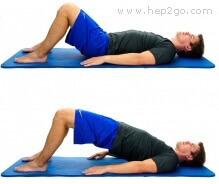
If you have damaged any of the soft tissues around the knee, such as the ligaments or cartilage, it is advisable to work on a rehab programme with a physical therapist who will be able to give you tailored hyperextended knee exercises.
They will work with you to help you make a full recovery and ensure you aren’t left with any long term instability or pain from your hyperextended knee which could make you more susceptible to further knee problems in the future.
You can find a whole range of hyperextended knee exercises with guidance on how to do them safely, how to progress and how to get the best results in the knee strengthening exercises section.
6. Medication
Your doctor may prescribe painkillers or anti-inflammatory medication to help reduce the pain and swelling as part of your hyperextended knee treatment.
7. Knee Surgery
In most cases, non-surgical hyperextended knee treatment is suficient, but if you have torn one of the knee ligaments with your knee hyperextension injury, particularly the ACL, you may require surgery to fix the torn tendon. The torn knee ligament is either repaired or replaced with a graft, depending on the severity of the tear.
Recovery tends to be slow but with the correct rehab you should make a full recovery.
You can find out how to tell if you need surgery, what it involves and all about the recovery process in the ACL Surgery section.
Hyperextended Knee Recovery
How long does it take for a hyperextended knee to heal? Recovering from a mild knee hyperextension injury may take as little as two weeks, but if there is associated ligament damage, it may takes months to fully recover.
What do you do for hyperextended knees? In the early stages following knee hyperextension injuries it is important to take it easy and follow PRICE principles. If you try to get back to sports too quickly you risk further injury. Keep the knee gently moving but avoid activities that hurt, especially if they cause discomfort, particularly if it takes longer than twenty minutes to settle when you rest. Once the pain and swelling start to subside you can start doing hyperextended knee exercises to strengthen the knee muscles.
What if I've got other injuries? If you have sprained or torn any of the knee ligaments or damaged the knee cartilage, you really should work with a physical therapist on a rehab programme to ensure you regain full motion, strength, flexibility and stability at the knee. It will also help to reduce the recovery time. You may need crutches or a knee brace for a period of time.
Is hyperextension bad for your knees? Mild knee hyperextension may not cause any pain but if there is increased laxity at the knee joint and repetitive hyperextension, there is increased risk of knee damage including ligament tears and cartilage damage.
You can find out more about recovering from the possible injuries associated with a hyperextended knee injury in the knee sprain, ACL injury and meniscus tear sections.
Preventing Knee Hyperextension Injuries
There are a couple of things you can do to reduce the risk of a hyperextended knee:
- Warm Up: before playing sports so that your body and muscles are ready for action
- Strengthening Exercises: Having good strength and core stability helps to protect the knee from hyperextension injuries. This is particularly important if you are hypermobile
- Wear A Knee Brace: Knee braces can help reduce the risk of hyperextension injuries, but are only really advised if you already suffer from a hyperextended knee. Some of the more sophisticated hinged braces, such as Donjoy braces, can actually be locked into position making it virtually impossible to hyperextend your knee.
Genu Recurvatum Syndrome
Genu recurvatum syndrome is a condition, rather than an injury, where the knee chronically hyperextends. This means that anytime you fully straighten the knee, it extends backwards past the normal neutral resting point of the knee. This may happen when you are standing, sitting or lying down.
The normal range of movement at the knee is 0-135 degrees i.e. fully straight (0o) to fully bent (135o). If the knee extends more than 10 degrees past neutral, that is classed as hyperextension.
Genu recurvatum is more common in women due to increased ligament laxity and there is often a genetic link.
There are a number of other things that can cause genu recurvatum syndrome including:
- Ligament Laxity
- Muscle Weakness
- Leg Length Discrepancy
- Medical Conditions: such as Ehlers-Danlos syndrome, Cerebral Palsy and Muscular Dystrophy
- Upper or Lower Motor Neurone Syndrome
Treatment for genu recurvatum usually involves:
- Medication: if the hyperextension is due to a medical condition
- Physical and Occupational Therapy
- Knee Splints, Orthotics & Braces: to provide support to the knee
- Knee Surgery
Hyperextended Knee Summary
Knee hyperextension occurs when the knee joint is extended beyond its normal range of motion, leading to pain and discomfort. Common causes of a hyperextended knee are overstretching or straining of the knee ligaments or muscles, accidents or falls onto the knee, or improper lifting.
Hyperextended knee treatment typically involves rest, physical therapy, non-steroidal anti-inflammatory drugs (NSAIDs) for pain relief, and ice and compressive wraps to reduce inflammation and swelling. In more severe cases, surgery may be needed to repair any damage in the knee joint.
With a hyperextended knee it is really important to know whether there are any associated injuries to ensure you get the right treatment so make sure you are assessed by a doctor.
If this isn’t sounding quite like your problem or you want some help working out what is wrong, visit the knee pain diagnosis section, but please remember, that is not a substitute for medical advice.
And remember, knee strengthening exercises are vital with a hyperextended knee to build up the strength and stability of the knee to ensure a full recovery.
You might also be interested in the following articles:
- Front Knee Pain
- Inner Knee Pain
- Outer Knee Pain
- Pain Behind the Knee
- Knee Pain On Stairs
- Knee Pain & Popping
- Swollen Knee Treatment
Page Last Updated: 21/03/23
Next Review Due: 21/03/25
